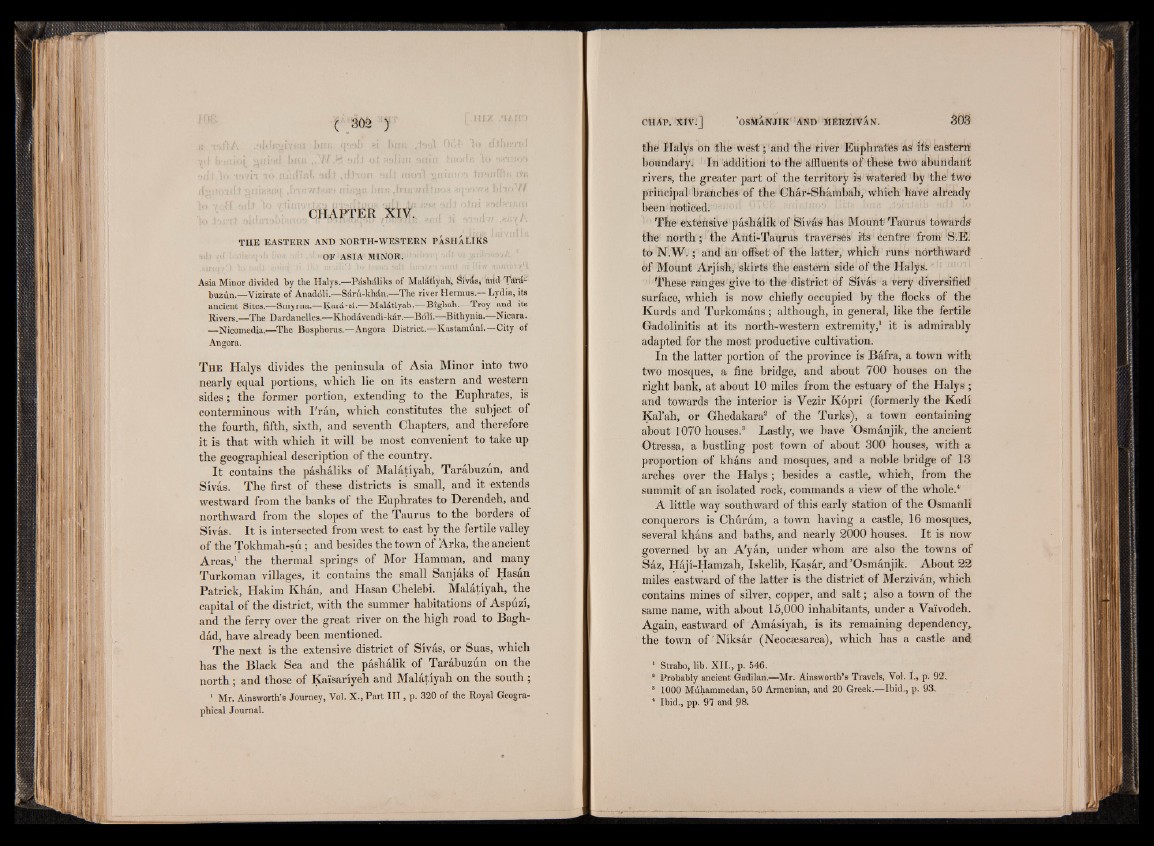
CHAPTER XIV.
THE EASTERN AND NORTH-WESTERN PÀSHaLIKS
OF ASIA MINOR.
Asia Minor divided by the Halys.—Pàshiiliks of MaMtlyah, Sivils, arid Tara-
bnzim.—Vizirate of Anadóli.—Sàrù-khdn.—The river Hermus. Lydia, its
ancient Sites.—Smyrna.—Kard-si.— Maldtlyah.— Bigliah.—Troy and its
Rivers.—-The Dardanelles.—Khoddvendi-kàr.—Bòli.—Bithynia—Nicara.
—Nicomedia.—The Bosphorus.—Angora District.—Kastamuni.—City of
Angora.
T h e Halys divides the peninsula of Asia Minor into two
nearly equal portions, which lie on its eastern and western
sides ; the former portion, extending to the Euphrates, is
conterminous with I'ran, which constitutes the subject of
the fourth, fifth, sixth, and seventh Chapters, and therefore
it is that with which it will he most convenient to take up
the geographical description of the country.
It contains the pàshàliks of Malatiyah, Taràbuzun, and
Sivàs, The first of these districts is small, and it extends
westward from the banks of the Euphrates to Derendeh, and
northward from the slopes of the Taurus to the borders of
Sivàs. It is intersected from west to east by the fertile valley
of the Tokhmah-su ; and besides the town of Arka, the ancient
Areas,1 the thermal springs of Mor Hamman, and many
Turkoman villages, it contains the small Sanjàks of Hasan
Patrick, Hakim Khan, and Hasan Chelebi. Malatiyah, the
capital of the district, with the summer habitations of Aspuzi,
and the ferry over the great river on the high road to Baghdad,
have already been mentioned.
The next is the extensive district of Sivàs, or Suas, which
has the Black Sea and the pashalik of Tarabuzun on the
north ; and those of Kaisariyeh and Malatiyah on the south ;
1 Mr. Ainsworth’s Journey, Vol. X., Part I I I , p. 320 of the Royal Geographical
Journal.
the) Halys on the west ; and the» fiver Euphrates as its eastern
boundary. In addition to the affluents of these two abundant
rivers, the greater part of the territory is Watered! by the two
principal branchés Of the Châr-Shâmbah, which have already
been noticed.
The extensivepâshàlik of Si vas has Mount Taurus towards
the north ; the Anti-Taurus traverses1 its centre from S.E.
to N.W. ; and an offset of the latter, which runs northward
of Mount Arjish, skirts the eastern side of the Halys.
1 These ranges give to the district Of Si vas a very diversified1
surface, which is now chiefly occupied by the flocks of the
Kurds and Turkomans ; although, in general, like the fertile
Gadolinitis at its north-western extremity,1 it is admirably
adapted for the most productive cultivation.
In the latter portion of the province is Bâfra, a town with
two mosques, a fine bridge, and about 700 houses on the
right bank, at about 10 miles from the estuary of the Halys ;
and towards the interior is Vezir Kopri (formerly the Kedi
Kal’ah, or Ghedakara2 of the Turks), a town containing
about 1070 houses.3 Lastly, we have ’Osmânjik, the ancient
Otressa, a bustling post town of about 300 houses, with a
proportion of khans and mosques, and a noble bridge of 13
arches over the Halys ; besides a castle, which, from the
summit of an isolated rock, commands a vie w of the whole.4'
A little way southward of this early station of the Osmanli
conquerors is Churum, a town having a castle, 16 mosques,
several khâns and baths, and nearly 2000 houses. It is now
governed by an A'yân, under whom are also the towns of
Sâz, Hâji-Hamzah, Iskelib, Kasâr, and’Osmânjik. About 22
miles eastward of the latter is the district of Merzivân, which
contains mines of silver, copper, and salt ; also a town of the
same name, with about 15,000 inhabitants, under a Vaïvodeh.
Again, eastward of Amâsiyah, is its remaining dependency,
the town of 'Niksâr (Neocæsarea), which has a castle and
1 Strabo, lib. X II., p. 546.
2 Probably ancient Gadilan.—Mr. Ainsworth’s Travels, Vol. I., p. 92.
8 1000 Mdhammedan, 50 Armenian, and 20 Greek.—Ibid., p. 93.
4 Ibid., pp. 91 and .98.